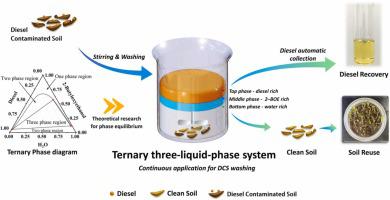Journal of Hazardous Materials ( IF 13.6 ) Pub Date : 2022-09-26 , DOI: 10.1016/j.jhazmat.2022.130061 Zhijie Shang 1 , Pan Xu 1 , Zhenyu Ke 1 , Meiling Yao 1 , Xinxue Li 1

|
Diesel contamination poses a serious threat to ecosystem and human health. This study proposes a novel method for simultaneous diesel removal and recovery from heavily diesel-contaminated soil by washing based on three-liquid-phase equilibria of diesel+2-butoxyethanol+water. This work covers both theoretical-cum-experimental explorations. For this brand-new ternary three-liquid-phase system (TPS), Ternary-Gibbs and Fish-Shaped phase diagrams were constructed through the phase behavior investigation to provide theoretical support for diesel removal/recovery. As the experiment demonstrated, the removal efficiency was up to 87.5 % for the contaminated soil with diesel content of 226,723 mg/kg, and the recovery rate reached 73.8 %. In addition, the TPS could also be used continuously during the washing process while avoiding solution purification, and the detached diesel would automatically float into the top phase without complicated separation. The mechanism of diesel removal was determined as the surface “stripping” effect based on ultralow interfacial tension, and the enhanced process involved “stripping+dissolution”. The treated soil contained almost negligible organic solvent residue and was therefore appropriate for plant cultivation. The recovered diesel exhibited less variation from commercial diesel in composition and properties, possessing a higher potential for reuse. Moreover, this study also provided key insights into the residual mechanisms of recalcitrant hydrocarbons in the soil.
中文翻译:

基于柴油+2-丁氧基乙醇+水三液相平衡的重柴油污染土壤柴油去除与回收
柴油污染对生态系统和人类健康构成严重威胁。本研究基于柴油+2-丁氧基乙醇+水的三液相平衡,提出了一种通过洗涤从重度柴油污染土壤中同时去除和回收柴油的新方法。这项工作涵盖了理论和实验的探索。针对这一全新的三元三液相系统(TPS),通过相行为研究构建了三元-吉布斯相图和鱼形相图,为柴油去除/回收提供理论支持。实验表明,柴油含量为226,723 mg/kg的污染土壤去除率高达87.5%,回收率达到73.8%。此外,TPS还可以在洗涤过程中连续使用,同时避免溶液纯化,分离出来的柴油会自动浮到顶相,无需复杂的分离。柴油去除机理确定为基于超低界面张力的表面“剥离”效应,强化过程为“剥离+溶解”。处理过的土壤含有几乎可以忽略不计的有机溶剂残留物,因此适合植物栽培。回收的柴油在成分和性能上与商业柴油相比变化较小,具有更高的再利用潜力。此外,这项研究还为土壤中顽固性碳氢化合物的残留机制提供了重要见解。柴油去除机理确定为基于超低界面张力的表面“剥离”效应,强化过程为“剥离+溶解”。处理过的土壤含有几乎可以忽略不计的有机溶剂残留物,因此适合植物栽培。回收的柴油在成分和性能上与商业柴油相比变化较小,具有更高的再利用潜力。此外,这项研究还为土壤中顽固性碳氢化合物的残留机制提供了重要见解。柴油去除机理确定为基于超低界面张力的表面“剥离”效应,强化过程为“剥离+溶解”。处理过的土壤含有几乎可以忽略不计的有机溶剂残留物,因此适合植物栽培。回收的柴油在成分和性能上与商业柴油相比变化较小,具有更高的再利用潜力。此外,这项研究还为土壤中顽固性碳氢化合物的残留机制提供了重要见解。具有更高的再利用潜力。此外,这项研究还为土壤中顽固性碳氢化合物的残留机制提供了重要见解。具有更高的再利用潜力。此外,这项研究还为土壤中顽固性碳氢化合物的残留机制提供了重要见解。



























 京公网安备 11010802027423号
京公网安备 11010802027423号